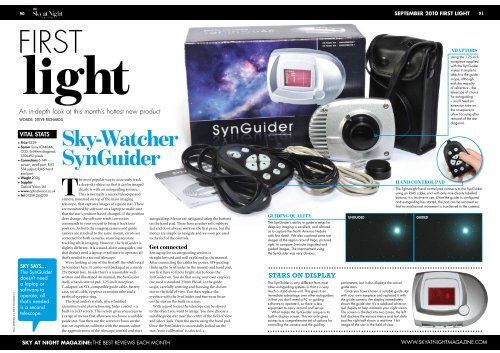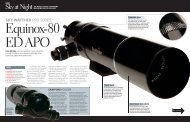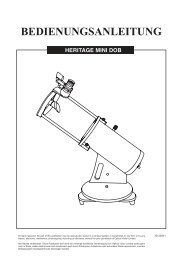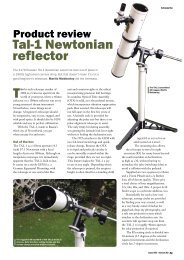Review of SynGuider by Sky At Night Magazine - Optical Vision Ltd
Review of SynGuider by Sky At Night Magazine - Optical Vision Ltd
Review of SynGuider by Sky At Night Magazine - Optical Vision Ltd
Create successful ePaper yourself
Turn your PDF publications into a flip-book with our unique Google optimized e-Paper software.
90 september 2010 first light 91<br />
first<br />
light<br />
An in-depth look at this month’s hottest new product<br />
words: Steve Richards<br />
Adaptors<br />
Using the 1.25-inch<br />
nosepiece supplied<br />
with the <strong>SynGuider</strong><br />
makes it simple to<br />
attach to the guide<br />
scope, although<br />
with the majority<br />
<strong>of</strong> refractors – the<br />
telescope <strong>of</strong> choice<br />
for autoguiding<br />
– you’ll need an<br />
extension tube on<br />
the nosepiece to<br />
allow focusing after<br />
removal <strong>of</strong> the star<br />
diagonal.<br />
paul whitfield x 2, steve richards x 3<br />
Vital stats<br />
• Price £229<br />
• Sensor Sony ICX404AL<br />
CCD; 6.69mm diagonal;<br />
510x492 pixels<br />
• Connections 6-14V<br />
power; serial port; RJ12<br />
ST4 output; RJ45 hand<br />
pad port<br />
• Weight 200g<br />
• Supplier<br />
<strong>Optical</strong> <strong>Vision</strong> <strong>Ltd</strong><br />
• www.opticalvision.co.uk<br />
• Tel 01359 244200<br />
<strong>Sky</strong> says…<br />
The <strong>SynGuider</strong><br />
doesn’t need<br />
a laptop or<br />
s<strong>of</strong>tware to<br />
operate; all<br />
that’s needed<br />
is a second<br />
telescope.<br />
<strong>Sky</strong>-Watcher<br />
<strong>SynGuider</strong><br />
The most popular way to accurately track<br />
a deep-sky object so that it can be imaged<br />
clearly is with an autoguiding system.<br />
This is normally a second telescope and<br />
camera, mounted on top <strong>of</strong> the main imaging<br />
telescope, that captures images <strong>of</strong> a guide star. These<br />
are monitored <strong>by</strong> s<strong>of</strong>tware on a laptop to make sure<br />
that the star’s position hasn’t changed. If the position<br />
does change, the s<strong>of</strong>tware sends correction<br />
commands to your mount to bring it back into<br />
position. As both the imaging camera and guide<br />
camera are attached to the same mount, errors are<br />
corrected for both cameras, ensuring accurate<br />
tracking while imaging. However, the <strong>SynGuider</strong> is<br />
slightly different. It is a stand-alone autoguider, one<br />
that doesn’t need a laptop or s<strong>of</strong>tware to operate; all<br />
that’s needed is a second telescope.<br />
We’re looking at one <strong>of</strong> the first <strong>of</strong>f-the-shelf retail<br />
<strong>SynGuider</strong>s here. It comes well packaged in a sturdy<br />
23x15x9cm box. Inside there’s a reasonably wellwritten<br />
and illustrated A6 manual, the <strong>SynGuider</strong><br />
itself, a hand control pad, 1.25-inch nosepiece,<br />
T-adaptor, an ST4-compatible guide cable, battery<br />
case, serial cable, eyepiece extension tube and a<br />
parfocal eyepiece ring.<br />
The <strong>SynGuider</strong>’s stylish, silver-finished<br />
aluminium and plastic housing hides a secret – a<br />
built-in LCD screen. This screen gives you access to<br />
a range <strong>of</strong> menus that allow you to choose a suitable<br />
guide star. You then use the screen to focus on the<br />
star, set exposure, calibrate with the mount, adjust<br />
the aggressiveness <strong>of</strong> the telescope control and start<br />
autoguiding. Menus are navigated using the buttons<br />
on the hand pad. These have a rather s<strong>of</strong>t, rubbery<br />
feel and don’t always work on the first press, but the<br />
menus are simple to navigate and we soon got used<br />
to the feel <strong>of</strong> the controls.<br />
Get connected<br />
Setting up for an autoguiding session is<br />
straightforward and well explained in the manual.<br />
After connecting the cables for power, ST4 guiding<br />
(linking the <strong>SynGuider</strong> to the mount) and hand pad,<br />
you first have to find a bright star to focus the<br />
<strong>SynGuider</strong> on. You do that using your own eyepiece<br />
(we used a standard 25mm Plössl) in the guide<br />
scope, carefully centring and focusing the chosen<br />
star in the field <strong>of</strong> view. You then replace the<br />
eyepiece with the <strong>SynGuider</strong> and fine-tune focus<br />
on the star on the built-in screen.<br />
With a good focus, the telescope can be slewed<br />
to the object you want to image. You now choose a<br />
suitable guide star near the centre <strong>of</strong> the field <strong>of</strong> view<br />
and select ‘lock’ from the menu using the hand pad.<br />
Once the <strong>SynGuider</strong> is successfully locked on the<br />
star, ‘auto-calibration’ is selected. ><br />
Guiding quality<br />
The <strong>SynGuider</strong>’s ability to guide a setup for<br />
deep-sky imaging is excellent, and allowed<br />
us to capture the North America Nebula<br />
with fine detail. We also captured some test<br />
images <strong>of</strong> the region around Vega, pictured<br />
right, to compare 5-minute unguided and<br />
guided images. The improvement using<br />
the <strong>SynGuider</strong> was very obvious.<br />
Stars on display<br />
The <strong>SynGuider</strong> is very different from most<br />
other autoguiding systems in that it is very<br />
much a stand-alone unit. This gives it an<br />
immediate advantage over other autoguiders<br />
in that you don’t need a PC or guiding<br />
s<strong>of</strong>tware to operate it, so there is less<br />
equipment to carry around and set up.<br />
What makes the <strong>SynGuider</strong> unique is its<br />
built-in display screen. This not only gives<br />
access to a comprehensive set <strong>of</strong> options for<br />
controlling the camera and the guiding<br />
UNGUIDED<br />
parameters, but it also displays the actual<br />
guide stars.<br />
Once you have chosen a suitable guide star<br />
with your own eyepiece and replaced it with<br />
the guide camera, the display immediately<br />
shows the guide star. It’s a subdued white-onred<br />
display to help maintain your night vision.<br />
The screen is divided into two zones, the left<br />
half displays the various menus and text data<br />
and the right half shows a real-time 1-bit<br />
image <strong>of</strong> the star in the field <strong>of</strong> view.<br />
Hand control pad<br />
The lightweight hand control pad connects to the <strong>SynGuider</strong><br />
using an RJ45 cable, and with only nine clearly labelled<br />
buttons, it is intuitive to use. Once the guider is configured<br />
and autoguiding has started, the pad can be removed so<br />
that no mechanical movement is transferred to the camera.<br />
GUIDED<br />
SKY AT NIGHT MAGAZINE: THE BEST REVIEWS EACH MONTH<br />
WWW.SKYATNIGHTMAGAZINE.COM
92<br />
first<br />
light<br />
september 2010<br />
first light<br />
Camera<br />
sensor<br />
The Sony ICX404AL<br />
CCD is 5.59mmx4.68mm<br />
(6.69mm diagonally) in<br />
size, giving a 48x40-<br />
arcminute field <strong>of</strong> view<br />
with our 80mm aperture,<br />
400mm focal length<br />
refractor guide scope.<br />
With 510x492 pixels, total<br />
resolution is over 250,000<br />
pixels, which is low for<br />
imaging but perfectly<br />
adequate for autoguiding.<br />
Parfocal ring<br />
This makes it easy to focus the <strong>SynGuider</strong> on different<br />
guide stars. After finding a guide star, focusing and<br />
centring with the eyepiece, and swapping in the<br />
<strong>SynGuider</strong> for fine focusing, you put the eyepiece back<br />
in with the parfocal ring on its barrel. It’s then slid out<br />
<strong>of</strong> the eyepiece holder until the view is focused and<br />
then the parfocal ring is locked. Now you’ll know that<br />
stars in focus with the eyepiece will be in focus in the<br />
<strong>SynGuider</strong> whenever you put it back in the focuser.<br />
Battery box<br />
To underline the stand-alone nature <strong>of</strong> the <strong>SynGuider</strong>,<br />
it comes with a battery box in a vinyl case that takes<br />
four D-sized 1.5V cells. Freedom from the need to<br />
connect to a bulky power source is very useful for<br />
portability, although you can connect the <strong>SynGuider</strong><br />
to a ‘powertank’ if you use one.<br />
paul whitfield x 3<br />
sky says…<br />
Now add these:<br />
1. <strong>Sky</strong>-Watcher<br />
Startravel 80T<br />
refractor<br />
2. <strong>Sky</strong>-Watcher<br />
guidescope<br />
mount<br />
3. <strong>Sky</strong>-Watcher<br />
EQ6 Pro<br />
SynScan mount<br />
> Calibration determines the <strong>SynGuider</strong>’s<br />
orientation and tests the sensitivity <strong>of</strong> the mount to<br />
guiding commands. This ensures that the <strong>SynGuider</strong><br />
controls the mount correctly in response to any<br />
movement <strong>of</strong> the guide star. Once that has been<br />
carried out, the system automatically starts to<br />
autoguide and your imaging session can commence.<br />
The autoguiding system works very well, but it<br />
isn’t as easy to set up as a more conventional guide<br />
camera and PC system. This is because <strong>of</strong> the need<br />
to swap between the eyepiece and the camera,<br />
although you soon get into the routine. The position<br />
<strong>of</strong> the screen on the rear <strong>of</strong> the camera isn’t ideal,<br />
especially for objects high in the sky: we had to do<br />
quite a lot <strong>of</strong> crawling around to view it properly.<br />
Using a star diagonal would make the system much<br />
more comfortable to use, but at the risk <strong>of</strong><br />
introducing some instability.<br />
The <strong>SynGuider</strong> is ideal if you use a DSLR from<br />
a dark site, since there’s no need for a PC and both<br />
imaging and guiding cameras can be completely<br />
self-contained. Price has always been an issue with<br />
other stand-alone autoguiders – you previously<br />
had to spend a similar amount to a PC and a<br />
conventional guide camera combined. But the<br />
<strong>SynGuider</strong> changes all that: what we have here is<br />
a complete system that costs less than many<br />
conventional guide cameras on their own. S<br />
Verdict<br />
Build & design 87%<br />
Connectivity 88%<br />
Ease <strong>of</strong> use 90%<br />
Features 88%<br />
Guiding accuracy 92%<br />
Overall 89%<br />
SKY AT NIGHT MAGAZINE: THE BEST REVIEWS<br />
WWW.SKYATNIGHTMAGAZINE.COM










